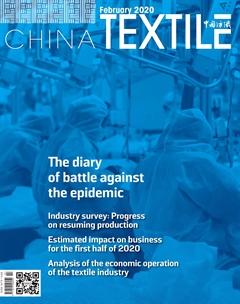Questionaires survey shows coronavirus impact on Chinese textile industry


A novel coronavirus got running rampant across China since its outbreak in December at the end of 2019 and made its way to a global health crisis as the World Health Organization (WHO) declared it a Public Health Emergency of International Concern (PHEIC) on January 30th, 2020, and China was hit the hardest due to the very special time when the whole country was overwhelmed with joys in Spring Festival in jubilant family reunion and friends and relatives gathering for China Lunar New Year that started on January 25th, to the neglect of the possible contagion if we see, the traditional legacy sets hundreds of millions of people on homebound journey on trains, planes, ships and highway driving, making the epidemics prevention and control equally the hardest, then. Chinese government has taken proactive efforts in all perspectives to curb the epidemic not only by reinforcing medical rescuers fighting on coronavirus-ridden frontline, but also by strictly carrying out various backing-up measures to impede the epidemic spread, including prolonging holidays for longer homestay, constraining outdoor activities with less transportation, delaying back-to-work time, which results in temporary slowdown of growth speed in national economy, and textile industry does not bear the brunt of the impact, but never walks away easy.
A national online survey in Questionaires was conducted by China National Textile and Apparel Council(CNTAC) from February 7th - 10th, with a report circulated only to limited readership to show a comprehensive outlook and insight of the textile industry by specific sectors in different provinces on the basis of 1,201 respondents, just a sample of the whole textile economic fabric if we can see wood and forest.
In geographic view, the companies in Central China(except Hubei province, the most catastrophic area this time) have been reopened to production more than that in the eastern part of the country. Jiangsu is the largest textile province in eastern China, with its operation resumed at less than 6 percent of all its respondent companies received in the Questionaires while the companies in Henan, Jiangxi and Anhui provinces in the Central China have a better rate in reopened operation respectively by 26.1%, 18.2% and 12.9%.
Protuberant problems
The outstanding problems at the moment are questioned and answered to the point that 69.1% of the respondents goes to short of hands or employees having no way to come back to work, 68.2% goes to impediment to logistics or transportation, 54.3% goes to procrastination of production schedule or possibility of default on delivery, etc.

The following table shows these key problems that challenge the specific sector with 83.3% going to textile machinery and 80.3% going to dyeing and printing sector in the labor shortage column, while manmade fiber and industrial textile sectors have more protuberant problems in impediments to transportation and logistics respectively by 89.4% and 78.2%. The wool textile businesses have different highlight of problems particularly in production schedule delay and contract default risk.
Impact on export
When the novel coronavirus was wide-spreading and declared as a PHEIC, the impact on export in the whole textile industry was a tangible reach and touch, making it hard or even impossible for Chinese textile business people to visit clients overseas as some countries have imposed unnecessary tour caveats for their own citizens and travel bans on Chinese visitors by over-reacted measures. New orders are yet to be seen in a worrying uncertainty, and even the containers already shipped to the clients are confronted with the delayed disembarkation or intensified quarantine check backed up by too many complicated red-tape procedures. Approximate 60 percent of the companies in the Questionaires responded to say that their export business is restricted by the country of export market as a consequence of the epidemic right now.
- China Textile的其它文章
- Dear readers
- The diary of battle against the epidemic
- Duan Xiaoping:Firm confidence,adapt to change,win in the future
- How is the progress of all industries in the second week of resumption of work?
- Industry survey:Progress on resuming production
- Survey on the work resumption of 4,650 enterprises in 19 clusters of cotton textile enterprises

